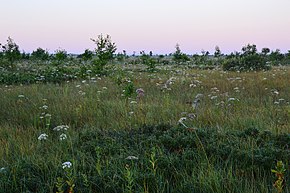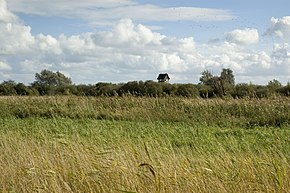

A fen is a type of peat-accumulating wetland fed by mineral-rich ground or surface water.[1][2] It is one of the main types of wetland along with marshes, swamps, and bogs. Bogs and fens, both peat-forming ecosystems, are also known as mires.[2] The unique water chemistry of fens is a result of the ground or surface water input. Typically, this input results in higher mineral concentrations and a more basic pH than found in bogs. As peat accumulates in a fen, groundwater input can be reduced or cut off, making the fen ombrotrophic rather than minerotrophic. In this way, fens can become more acidic and transition to bogs over time.[2]
Fens can be found around the world, but the vast majority are located at the mid to high latitudes of the Northern Hemisphere.[2] They are dominated by sedges and mosses, particularly graminoids that may be rarely found elsewhere, such as the sedge species Carex exilis.[3] Fens are highly biodiverse ecosystems and often serve as habitats for endangered or rare species, with species composition changing with water chemistry.[2] They also play important roles in the cycling of nutrients such as carbon, nitrogen, and phosphorus due to the lack of oxygen (anaerobic conditions) in waterlogged organic fen soils.[1]
Fens have historically been converted to agricultural land.[4] Aside from such conversion, fens face a number of other threats, including peat cutting, pollution, invasive species, and nearby disturbances that lower the water table in the fen, such as quarrying.[5] Interrupting the flow of mineral-rich water into a fen changes the water chemistry, which can alter species richness and dry out the peat. Drier peat is more easily decomposed and can even burn.[1][2]
- ^ a b c Cite error: The named reference
:22was invoked but never defined (see the help page). - ^ a b c d e f Cite error: The named reference
:62was invoked but never defined (see the help page). - ^ Chapin, Carmen T.; Bridgham, Scott D.; Pastor, John (March 2004). "pH and nutrient effects on above-ground net primary production in a Minnesota, USA bog and fen". Wetlands. 24 (1): 186–201. doi:10.1672/0277-5212(2004)024[0186:PANEOA]2.0.CO;2. ISSN 0277-5212. S2CID 36353650.
- ^ Cite error: The named reference
:42was invoked but never defined (see the help page). - ^ Cite error: The named reference
:15was invoked but never defined (see the help page).